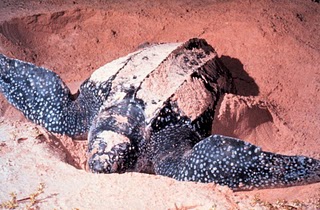Poikilothermy is one my favorite words in Biology. The first syllable rhymes with “Boy”, the second part is like “key low” and the last part rhymes with “wormy”. This mouthful is the term scientists use for animals with variable body temperatures (poikilos means varied in Greek). You might have heard the term cold-blooded applied to reptiles and fish but decades of research have shown that these animals are more thermally complex than the name implies.

Many poikilotherms have a preferred range of body temperature and use behavioral and physiological adaptations to achieve the optimal level. On a cool morning a snake might move into a sunny area to absorb heat from the sun. In a large lake, a fish might move into deeper, cooler water when surface waters get too warm.
Not having to waste energy to generate body heat can be a competitive advantage for poikilotherms. More time spent looking for food would mean greater chances of being eating by a predator.
 Having a large body size can help poikilotherms cope with changing environmental temperatures. Large sea turtles like the Leatherbacks can dive to very deep depths in the cold ocean in search of prey because their massive bodies take a long time to cool off. Scientists believe that large dinosaurs and marine reptiles of the Mesozoic era took advantage of the same principles.
Having a large body size can help poikilotherms cope with changing environmental temperatures. Large sea turtles like the Leatherbacks can dive to very deep depths in the cold ocean in search of prey because their massive bodies take a long time to cool off. Scientists believe that large dinosaurs and marine reptiles of the Mesozoic era took advantage of the same principles.
Homeotherms (like humans and other mammals) dedicate a significant amount of their energy intake to maintaining a constant body temperature. Because their body temperatures are usually higher than ambient temperatures, they are often referred to as warm-blooded. Scientist don’t use this term in part because some homeotherms maintain internal temperatures that are below outside temperatures (think of a kangaroo rat in a hot desert).
Despite requiring as much as 10 X more food than poikilothermy, homeothermy appears to lend several evolutionary advantages. Most of the complex brains and highest performing muscle systems in the Animal kingdom are found in homeotherms.
Photos are in the public domain and were produced by the US Geological Survey (Rattlesnake) and National Oceanic and Atmospheric Administration (Leatherback turtle)